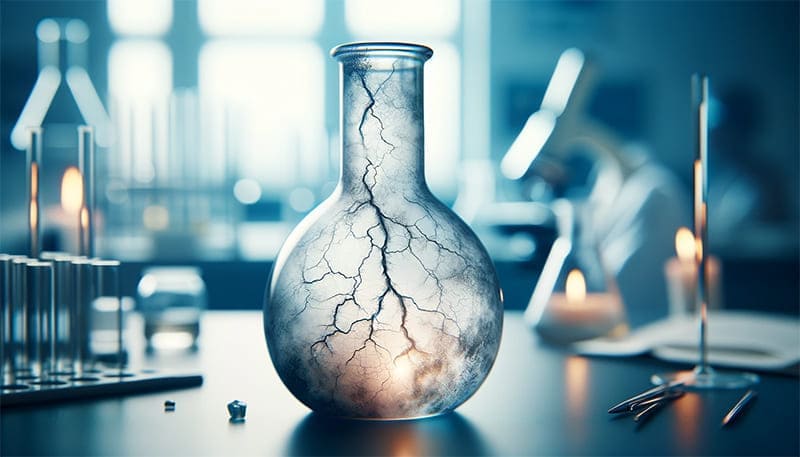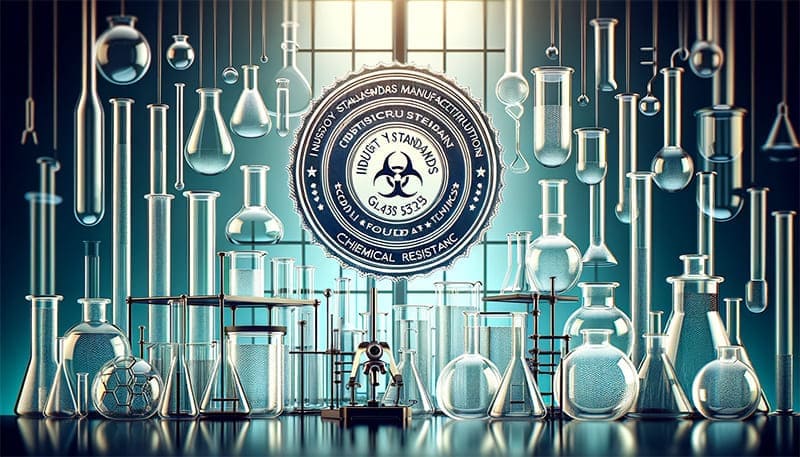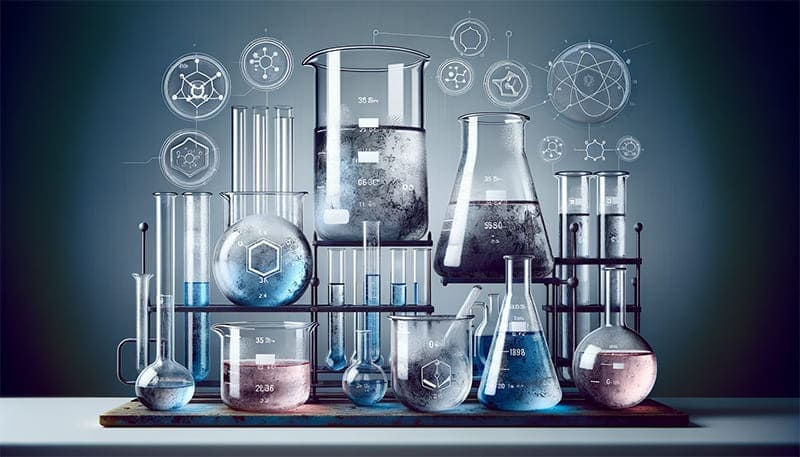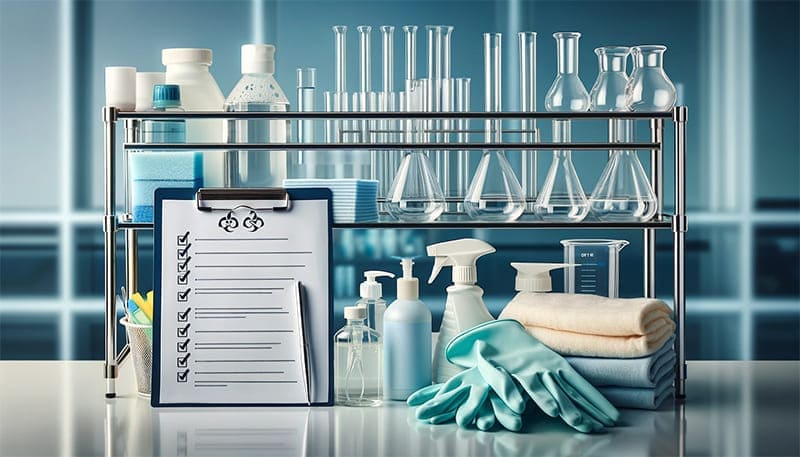Have you ever peered into your lab, bewildered at the etched and brittle glassware? Why does glassware, meant to be durable and resistant, succumb to wear and tear, despite meticulous care? Is it merely the passage of time, or are unseen aggressors at work?
Laboratory glassware is often subjected to a variety of chemicals for experiments and storage. Some of these chemicals, particularly acids, alkalis, and salts, can cause significant corrosion, leading to the deterioration of glassware. Understanding which chemicals are the culprits can help mitigate their damaging effects, ensuring the longevity and reliability of these essential lab tools.
Keep reading to unveil the hidden enemies of your lab glassware!

What Causes Glassware Corrosion
The main culprits of glassware corrosion are aggressive chemicals that react with the silica in glass. Commonly used acids like hydrofluoric acid and phosphoric acid, alkalis such as sodium hydroxide, and even some organic solvents can cause significant damage. These substances attack the glass surface, leading to etching, cracking, and ultimately failure of the glassware.
Specific Substances Causing Corrosion in Glassware
Glassware is a staple in many laboratories, prized for its transparency, chemical resistance, and ease of cleaning. However, even this robust material is vulnerable to certain chemicals. Below, we outline the specific substances that are known to cause corrosion in glassware and the mechanisms by which they do so.
Some chemical substances can corrode glassware, including:
- Acids: Substances like hydrochloric acid, sulfuric acid, nitric acid, etc., can react with components like silicon dioxide in glassware to produce corrosive substances such as hydrofluoric acid, leading to corrosion.
- Bases: Substances like sodium hydroxide, potassium hydroxide, ammonium hydroxide, etc., can react with silicon dioxide in glassware to produce sticky substances like sodium silicate, which adhere to the glassware surface and affect its smoothness or even cause it to break.
- Oxidizers: Potassium permanganate, potassium nitrate, hydrogen peroxide, etc., might react with certain components in glassware, producing corrosive substances that lead to corrosion.
- Reducers: Metals like sodium and magnesium might react with components in glassware to produce corrosive substances, leading to corrosion.
- Organic Solvents: Ethanol, acetone, toluene, etc., might dissolve certain components in glassware, producing corrosive substances and causing corrosion.
- High-Temperature Materials: Substances like hot sand or hot metal might cause uneven heating of glassware, leading to thermal stress and breakage.
Recognizing the substances that can corrode glassware is crucial for maintaining the longevity and functionality of these essential laboratory tools. By understanding the interactions and taking preventative measures, laboratory personnel can ensure the safety and effectiveness of their glass instruments. Proper knowledge and care are the best defenses against the corrosive effects of these chemicals on glassware.

Industry Standards in Glassware Manufacturing for Chemical Resistance
The manufacturing of laboratory glassware is governed by stringent industry standards, ensuring that the products are robust enough to withstand chemical attacks and meet the rigorous demands of scientific research. These standards play a pivotal role in maintaining the quality and safety of glassware used in laboratories worldwide.
Key Standards Ensuring Chemical Resistance
- ISO (International Organization for Standardization) Standards: ISO sets global standards for laboratory glassware. For instance, ISO 3585 specifies requirements for borosilicate glass, known for its excellent chemical resistance. These standards ensure that glassware can endure various chemical exposures without degradation.
- ASTM (American Society for Testing and Materials) Standards: ASTM provides detailed guidelines on the chemical durability of glass. ASTM E438, for instance, classifies glass into different types based on its resistance to water, acids, and alkali. This classification helps laboratories select the appropriate glass type for specific chemical environments.
- EN (European Norm) Standards: In Europe, EN standards, like EN ISO 4796, outline specifications for laboratory glassware, focusing on its ability to resist chemical attacks. These standards are harmonized with international guidelines to ensure consistent quality and safety.
Importance of Adherence to Standards
Adhering to these standards is crucial for manufacturers to produce glassware that can reliably withstand chemical corrosion. Laboratories depend on this compliance to ensure that their experiments and tests are conducted in a safe, controlled environment without the risk of glassware failure due to chemical reactions.
Moreover, these standards provide a benchmark for quality and safety, helping laboratories make informed decisions when procuring glassware. By choosing products that meet these recognized standards, laboratories can trust that they are investing in equipment that will not only be durable but also provide accurate and reliable results in their scientific endeavors.
Industry standards in glassware manufacturing play an indispensable role in ensuring that the products are capable of withstanding the harsh chemical environments often encountered in laboratories. The adherence to these standards is a testament to the commitment of manufacturers to quality, safety, and reliability in scientific research.

Types of Glassware and Their Susceptibility to Corrosion
In laboratories, glassware is indispensable for its durability, inertness, and clarity. However, not all glass is the same. Different types of glass have varying levels of resistance to chemicals due to their composition. Here we explore the common types of laboratory glassware and their susceptibility to chemical corrosion.
Borosilicate Glass
- Composition: Primarily composed of silica and boron trioxide.
- Characteristics: Highly resistant to thermal shock and most chemicals.
- Common Use: Widely used for reagent bottles, beakers, flasks, and other standard labware.
- Chemical Resistance: Excellent resistance to acidic and neutral solutions but can be corroded by strong alkaline solutions over time.
Soda-Lime Glass
- Composition: Made from sodium carbonate, lime, and silica.
- Characteristics: Cheaper and less chemical resistant than borosilicate glass.
- Common Use: Often used for windows, bottles, and jars.
- Chemical Resistance: Susceptible to hydrofluoric acid and strong alkaline solutions, causing it to deteriorate more quickly than borosilicate glass.
Lead Glass
- Composition: Contains lead oxide in its silica matrix.
- Characteristics: Known for its high optical quality and resistance to certain types of radiation.
- Common Use: Primarily used in optical applications and radiation shielding.
- Chemical Resistance: Good resistance to many acids but can be degraded by alkali and hydrofluoric acid.
Quartz Glass
- Composition: Almost pure silica.
- Characteristics: Exceptional thermal and chemical stability, can withstand very high temperatures.
- Common Use: Crucibles, high-temperature tubes, and windows.
- Chemical Resistance: Highly resistant to most acids, bases, and solvents, but can be corroded by hydrofluoric acid and hot phosphoric acid.
Aluminosilicate Glass
- Composition: Contains alumina in addition to silica.
- Characteristics: Known for its durability and resistance to thermal shock.
- Common Use: Used in high-temperature and tough industrial applications.
- Chemical Resistance: Resistant to most acids and bases, except for hydrofluoric acid and concentrated phosphoric acid.
Here is a comparative analysis table of the resistance levels of different glass types to common laboratory chemicals:
| Glass Type | Acids | Bases | Organic Solvents | Thermal Shock | Special Notes |
|---|---|---|---|---|---|
| Borosilicate | Excellent | Good | Excellent | Excellent | Vulnerable to strong alkalis |
| Soda-Lime | Poor | Poor | Good | Poor | Susceptible to rapid degradation |
| Lead Glass | Good | Poor | Good | Fair | Avoid prolonged exposure to alkalis |
| Quartz Glass | Excellent | Excellent | Excellent | Excellent | Costly but highly resistant |
| Aluminosilicate | Good | Good | Excellent | Excellent | Good for high-temp applications |
Understanding the type of glass and its chemical resistance is crucial for ensuring the longevity of laboratory glassware and the safety and accuracy of experiments. By selecting the appropriate type of glassware for specific chemicals and conditions, laboratory personnel can prevent premature corrosion and damage, thereby extending the life of their glassware and maintaining the integrity of their scientific work.
How Can You Identify the Damage
The first signs of corrosion are often subtle. You might notice a slight haze or etching on the surface, or the glass may become brittle and prone to breakage. Over time, these signs worsen, leading to unsafe conditions or inaccurate experimental results. Regular inspection and understanding the chemical history of your glassware are crucial in early identification and prevention.

Preventive Measures and Care
Preventing corrosion starts with understanding the chemical compatibility of glassware. Always refer to chemical resistance charts before using any substance with glass. Additionally, proper cleaning, storage, and handling can minimize the risk of damage. Rinse glassware immediately after use, avoid extreme temperature changes, and store it carefully to prevent scratches or stress.
To mitigate the corrosion of glassware by chemicals, the following measures can be adopted:
- Select Suitable Glassware: Choose the right glassware according to the experimental needs, such as those resistant to acid-base or high temperatures.
- Avoid Prolonged Contact: Minimize contact with corrosive substances, especially strong acids and bases.
- Proper Cleaning: Use appropriate detergents and cleaning methods, avoiding harsh materials that could scratch or damage the glassware.
- Staff Training: Enhance safety awareness and operation skills of laboratory personnel.
- Storage and Management: Establish a system for the storage and management of glassware, ensuring a dry, ventilated, and light-protected environment, with regular checks and maintenance.
- Use Alternative Materials: In some experiments, use instruments made of non-glass materials like plastic or ceramic to reduce the risk of corrosion and breakage.
- Monitor Temperature and Pressure Changes: Be mindful of temperature and pressure changes during use to prevent breakage due to sudden shifts.
- Handle with Care: Gently handle glassware to avoid damage from strong vibrations or impacts.
When to Replace
Even with the best care, glassware has a limited lifespan. Regular inspections will help identify when the glassware is no longer fit for use. Look for signs of severe etching, cloudiness, or cracks. If you’re unsure, it’s always better to replace than to risk a failure during critical experiments.
Conclusion
Embark on a journey to safeguard your scientific endeavors by understanding the hidden adversaries of your lab – corrosive chemicals. Embrace the robustness of informed choices in glassware and maintenance practices, ensuring precision and safety in every experiment. Let “Unmasking the Culprits: Chemicals That Corrode Your Lab Glassware” be your guide in nurturing a culture of durability and excellence in your scientific sanctuary. Act now, and preserve the integrity of your research for generations to come!










